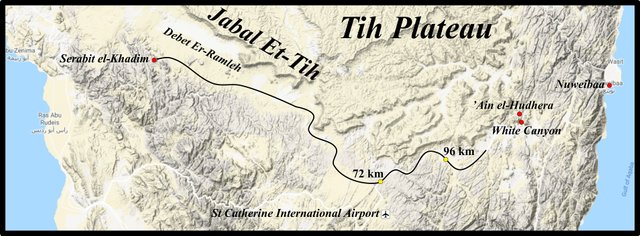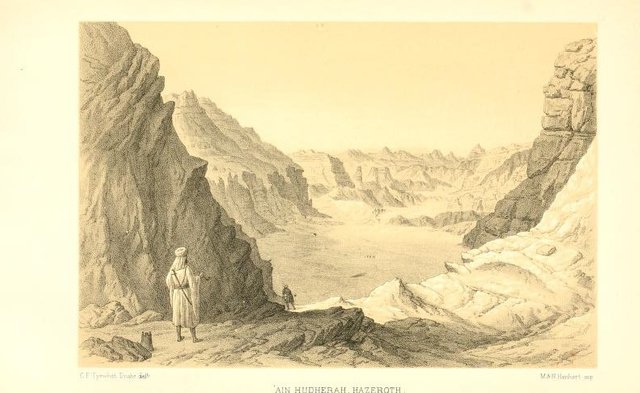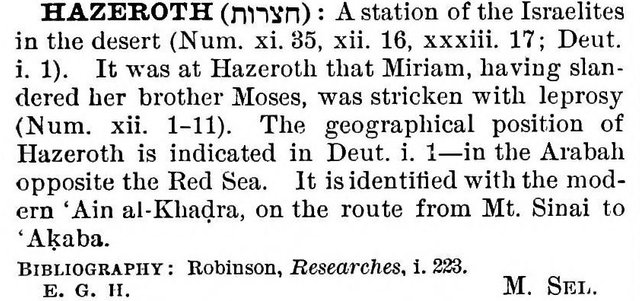
The Fourteenth Station of the Exodus, Hazeroth, is most frequently identified with a spring or well known today as ‘Ain el-Hudhera, which lies about 1 km north of White Canyon:

This identification was first made by the Swiss Orientalist and traveller Johann Ludwig Burckhardt in the early 19th century (Burckhardt 495). The Scottish orientalist and missionary John Wilson concurred, writing in 1847:

The plain of el-Hadharah runs a long way to the eastward of the place where we were. It is the general name, we learned from the Arabs, of the sandy plateau between Jebel et-Tíh, and the Sinaitic range. It is crossed by several minor Wádís, by which its drainage is carried to the sea of Akabah at Dahab. As it was not designated in any of the maps which we had with us, I was particular in my inquiries about it with our Arabs; and I carefully wrote down its name in the Arabic character, when I heard it pronounced by them. I have been glad to observe this plateau in Russeger’s new map, published in 1844, as “plat. Alahadar,” which is nearly correct, if we make allowance for the confusion by the German naturalist of the Arabic article with the name itself Accurately written in Arabic, (خضرة), and observing the usual permutation of the final syllable, it exactly agrees with the Hebrew Hazeroth. I have not the slightest doubt, adverting to its locality and extent, that in some part of this valley was the station of the Israelites, mentioned in Numbers xi. 35. (Wilson 256)
Hazeroth is mentioned four times in the Bible:
And the people journeyed from Kibrothhattaavah unto Hazeroth; and abode at Hazeroth. (Numbers 11:35)
And Miriam was shut out from the camp seven days: and the people journeyed not till Miriam was brought in again. And afterward the people removed from Hazeroth, and pitched in the wilderness of Paran. (Numbers 12:15-16)
And they departed from Kibrothhattaavah, and encamped at Hazeroth. And they departed from Hazeroth, and pitched in Rithmah. (Numbers 33:17-18)
These be the words which Moses spake unto all Israel on this side Jordan in the wilderness, in the plain over against the Red sea, between Paran, and Tophel, and Laban, and Hazeroth, and Dizahab. (There are eleven days’ journey from Horeb by the way of mount Seir unto Kadeshbarnea.) (Deuteronomy 1:1-2)
According to Numbers 12, Moses’ sister Miriam was stricken with tzaraath (translated leprosy in the King James Version) at Hazeroth and put out of the camp for seven days. It was only after she had been cleansed that the Israelites resumed their journey.

Hazeroth
The name of this station is glossed by James Strong as the plural of a word that means yard or hamlet. It denotes a place that has been separated from the open country by a fence or stockade:

This etymology supports the popular identification with ‘Ain el-Hudhera (Orr 1347):

Deuteronomy 1:1, however, has been understood to place Hazeroth in the Arabah opposite the Red Sea:

This makes no sense to me: ‘Ain el-Hudhera does not lie in the Arabah, the arid valley between the Gulf of Aqaba and the Dead Sea. John Wilson also criticized this reading, believing that there were in fact two places called Hazeroth:
Deut. i. 1.—This text, which indicates the general course of the Israelites after leaving Sinai, is properly given in our translation as a parenthesis. It is preceded by the introduction of the book of Deuteronomy, “These be the words which Moses spake unto all Israel on this side Jordan, in the wilderness, in the plain over against the Red Sea, between Paran, and Tophel, and Hazeroth, and Dizahab.” Burckhardt, probably misled by the expression Red Sea, which is not in the original—for the word used there is only סוף Suph, identifies Dizahab with Dahab on the coast of the gulf of ’Akabah, directly east of Mount Sinai. Travels in Syria, p. 528. In this he is followed by Dr. Robinson, as may be seen from his excellent map of the peninsula of Mount Sinai. It is obvious, however, that Moses writes of a plain on the east of the Wádí ’Arabah, and on which Tophel, identified as the “Tafyle” (Tafeilah) of Burckhardt, lying between Bozrah and Kerak, occurs. The Hazeroth here mentioned must be different from the Hazeroth at which the Israelites encamped after leaving the “desert of Sinai,” and pitching at Kibroth-hattaavah, (Numbers xxxiii. 16,) and the identification of which we shall have occasion immediately to notice. (Wilson fn 4, 234-235)
Was Hazeroth a stockade? Not quite, according to Matthew George Easton:
HAZEROTH fenced enclosures consisting of “a low wall of stones in which thick bundles of thorny acacia are inserted, the tangled branches and long needle-like spikes forming a perfectly impenetrable hedge around the encampment” of tents and cattle which they sheltered. Such like enclosures abound in the wilderness of Paran, which the Israelites entered after leaving Sinai (Numbers 11:35; 12:16; 33:17, 18). This third encampment of the Israelites has been identified with the modern ‘Ain el-Hudhera, some 40 miles north-east of Sinai. Here Miriam (q.v.), being displeased that Moses had married a Cushite wife (Numbers 12: 1), induced Aaron to join with her in rebelling against Moses. God vindicated the authority of his “servant Moses,” and Miriam was smitten with leprosy. Moses interceded for her, and she was healed (Numbers 12:4-16). From this encampment the Israelites marched northward across the plateau of et-Tih, and at length reached KADESH. (Easton 537)
According to the list of Stations of the Exodus in Numbers 33, Hazeroth was the Israelites’ fourteenth encampment. Easton’s reference to it as the third encampment probably means third encampment after leaving the Mountain of God, which would be true if Taberah and Kibroth-Hattaavah were two different places. Easton, however, believes that Taberah was also called Kibroth-hattaavah (Easton 649).
Conclusion
Identifying Hazeroth with ‘Ain el-Hudhera makes perfect sense in the light of the route I am proposing. The principal objection that some scholars have made to this identification is the proximity of ‘Ain el-Hudhera to Jebel Musa, the traditional site of the Mountain of God (Hastings 314). But I have identified Serabit el-Khadim with the Mountain of God, which is approximately a four days’ march from ‘Ain el-Hudhera. This is in close agreement with the Scriptures.
To be continued ...
References
- Johann Ludwig Burckhardt, Travels in Syria and the Holy Land, John Murray, London (1822)
- Matthew George Easton, Illustrated Bible Dictionary, Harper & Brothers Publishers (1893)
- Louis Ginzberg, The Legends of the Jews, Volume 3, Translated from the German by Paul Radin, The Jewish Publications Society of America, Philadelphia (1911)
- James Hastings, A Dictionary of the Bible, Volume 2, T & T Clark, Edinburgh (1822)
- James K Hoffmeier, Ancient Israel in Sinai: The Evidence for the Authenticity of the Wilderness Tradition, Oxford University Press, Oxford (2005)
- James Orr (General Editor), The International Standard Bible Encyclopedia, Volume 4, The Howard-Severance Company, Chicago (1915)
- Edward Henry Palmer, Desert of the Exodus: Journeys on Foot in the Wilderness of the Forty Years’ Wanderings, Deighton, Bell, and Co, Cambridge (1871)
- Isidore Singer (managing editor), The Jewish Encyclopedia, Volume 6, Funk & Wagnalls Co, New York (1901)
- James Strong, Hebrew and Chaldee Dictionary, in The Exhaustive Concordance of the Bible, Eaton & Mains, New York (1890)
- John Wilson, The Lands of the Bible, Volume 1, William Whyte and Co, Edinburgh (1847)
Image Credits
- From Serabit el-Khadim towards ’Ain el-Hudhera: Google Maps, Map Data © 2020 Mapa GISrael, ORION-ME, Fair Use
- Map Symbol Plane Clip Art: Openclipart, Public Domain
- John Wilson: Joseph Brown (engraver), Moffatt (photographer), George Smith, Life of John Wilson, Public Domain

Hi! Did you know that steemit.com is now censoring users and posts based on their opinions?
All the posts of these users are gone!
https://github.com/steemit/condenser/commit/3394af78127bdd8d037c2d49983b7b9491397296
Here's a list of some banned users:
'roelandp', 'blocktrades', 'anyx', 'ausbitbank', 'gtg', 'themarkymark', 'lukestokes.mhth', 'netuoso', 'innerhive'See anyone you recognize? There could be more, they also have a remote IP ban list.
Will you be censored next?
Downvoting a post can decrease pending rewards and make it less visible. Common reasons:
Submit
very good historical post dear. keep in post
Downvoting a post can decrease pending rewards and make it less visible. Common reasons:
Submit